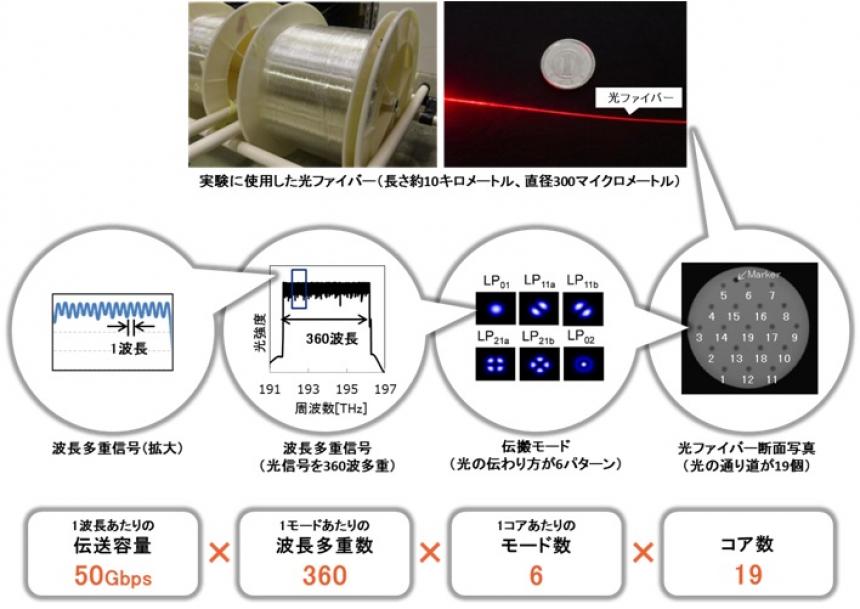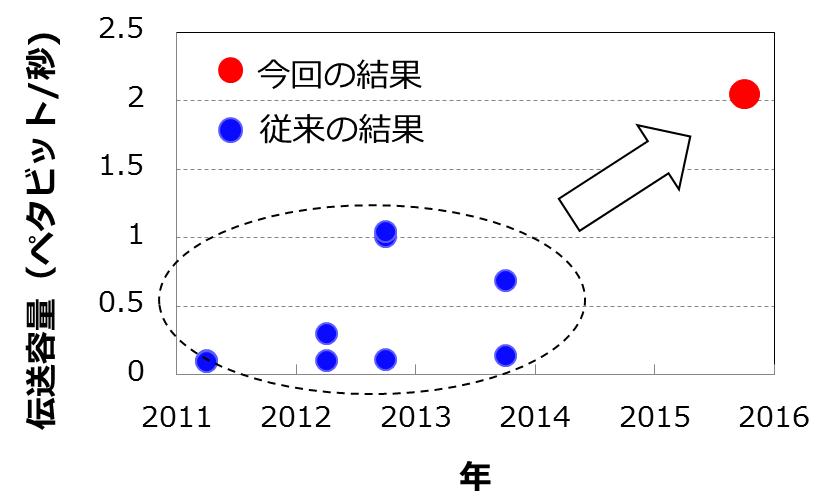 Print
Print
KDDI R&D Laboratories Achieves Ultra-High-Speed Data Transmission of 2 Pbps over Optical Fiber Approximately Double the World’s Previous Maximum Data Transmission Capacity
October 1, 2015
KDDI R&D Laboratories, Inc.
SAITAMA, JAPAN, October 1, 2015 — KDDI R&D Laboratories, Inc. announced today that it has successfully performed ultra-high-speed data transmission with a capacity of 2 petabits per second (Pbps)*1 over a single optical fiber in a field test. This is equivalent to transmitting the content of 10,000 Blu-ray discs (calculated at 25 gigabytes (GB) per disc) in one second, or to about 15,000 hours of 4K video (calculated at 16GB per hour).
KDDI R&D Laboratories will also announce this result at the 41st European Conference on Optical Communication (ECOC2015), which starts today (Central European Time).
In the future, with the implementation of 5G mobile communications and the explosive spread of IoT, as well as the increasing prevalence of 4K, 8K and other ultra-high-definition video formats, demand for high-capacity data communication is expected to far outpace current capacity. Given this, the challenge is to increase transmission performance over fiber optic networks so that customers can safely and comfortably enjoy data communications services.
KDDI R&D Laboratories succeeded in this 2 Pbps transmission test by combining two technologies.
The Company roughly doubled the world’s previous maximum transmission capacity*2 to 2 Pbps with 360 wavelength-division multiplexing (WDM) using Super-Nyquist-WDM technology that doubles a 50Gbps capacity per single wavelength over current capacity by narrowing the necessary signal band to the greatest extent possible. Moreover, using multi-core, multi-mode optical fiber*3 that can dramatically expand transmission capacity per optical fiber — one optical fiber contains six different propagation modes and 19 cores — enabled 114 space division multiplexing (SDM) transmission.
This transmission capacity is approximately 200 times*4 that of commercially available fiber optic systems.

In addition to further raising the performance of each of these technologies, KDDI R&D Laboratories will work on extending transmission distance and boosting transmission capacity to an even greater degree, looking to commercialize the technologies.
One part of this development is the result of research performed by the National Institute of Information and Communications Technology (NICT), specifically, the advanced telecommunications and broadcast R&D known as “i-FREE2” (2013-2018).
Figure 1: Image of optical fiber and technology used in the field trial

Figure 2 : Comparison of transmission capacity, previously and from this trial

END
*1: A peta is 1,000 trillion (1015); 2 Pbps = 2,000T (tera) bps = 2,000,000G (giga) bps
*2: A multi-core fiber transmission method that builds multiple cores into a single optical fiber and multiplexes differing signals, or, a multi-mode transmission fiber method that has multiple propagation modes built into a single core and that multiplexes differing signals; or a combination of both methods.
March 26, 2015 press release: “KDDI R&D Laboratories Achieves World’s Highest Frequency Usage Efficiency in Optical Fiber Transmission Field Trial.”
*3: Based on an announcement made at “Frontiers in Optics/Laser Science (FiO/LS) 2012,” according to KDDI R&D Laboratories’ own research. As of October 1, 2015.
*4: Compared with per-optical fiber transmission rates (10 Tbps) of the FASTER trans-Pacific submarine communications cable system (operations planned to commence from Q1 of fiscal 2016).
※The information contained in the articles is current at the time of publication.Products, service fees, service content and specifications, contact information, and other details are subject to change without notice.